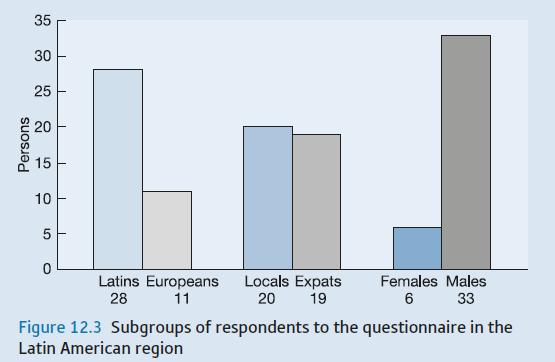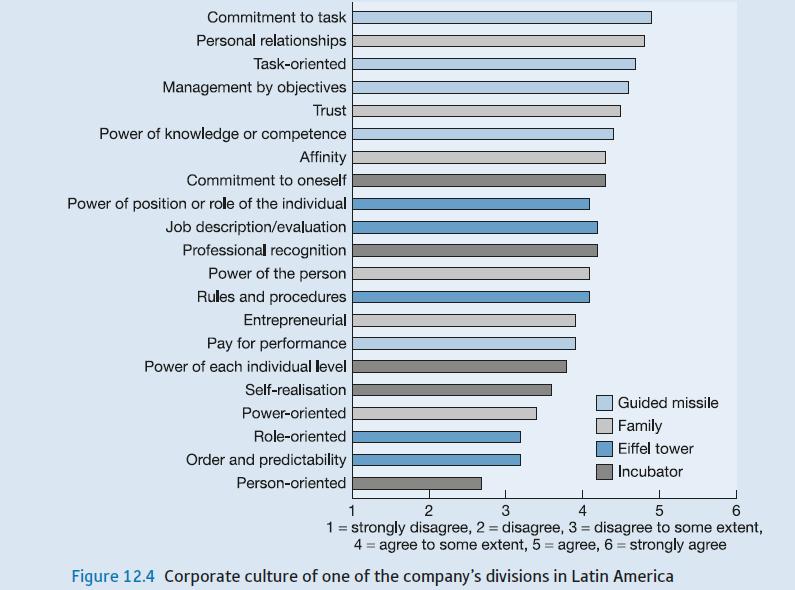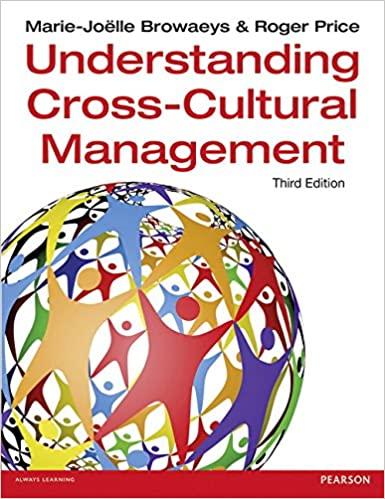This case study is related to the field of cultural management and focuses on a large international
Question:
This case study is related to the field of cultural management and focuses on a large international telecommunications company, which has operations in Latin America. It is specifically related to the networks division of this company.
The telecommunications industry has seen huge growth during the last couple of years in this part of the world. One important factor is that the GSM technology has been adapted as the standard in most Latin American countries and the local operators have adapted their mobile networks to this technology. The operations of the company in question consist of providing equipment and services for the local operators so they can build, operate and maintain a GSM mobile network.
During the last few years there has been important growth in terms of revenues, personnel and offices. The company is present in most Latin American countries ( Figure 12.2 ).

approach, the network division of this company is facing a cultural dilemma: should it maintain a diversified organisation in the specific country or should it ‘localise’ the organisation?
Diversity can be defined as a mixture of people with different groups of identities, such as gender, age, education, ethnicity, language or marital status. Diversity can also be related to work, such as seniority, management status, income or functional level of an employee. The advantages of diversity might be that it increases creativity, generates different opinions and opens the mind-set. This element of diversity plays an important role in the company. In fact, it sees itself as a multicultural company in which diversity is an important asset that enables the company to achieve extraordinary results. On the other hand, ‘localisation’
of personnel is also an important driver as it can, for instance, bring down costs and so make the company more competitive in the market. Another advantage of localisation can be that it increases cultural awareness within the company of the country within which it is operating. Locals naturally understand their customs, behaviours and language better than outsiders do.
COMPANY VALUES AND DIVERSITY
The corporate culture of the company is embedded in its culture and values. Despite the company’s rapid growth, including that of the network division, it has continued to stress a corporate culture more typical of an independent, innovative and creative start-up. The objective has always been to maintain this culture, no matter how large the company might become. The company believes the best way to achieve this goal is through leadership rather than traditional management. This first entails the leaders disseminating the company’s four values, defined in the 1990s, to everyone in the organisation. These values are: customer satisfaction, respect, achievement and renewal. They are applied worldwide and form the core element of the company culture as well as the basis for operations.
Furthermore, the company has defined goals with respect to diversity, a concept it defines as: ‘Any demographic and individual attribute that defines each person as a unique individual. It means all the ways we are different from each other.’
First of all, the company wants to encourage innovation which, it believes, can best be achieved by well-managed teams whose members come from diverse cultures. These teams are usually more creative and find better solutions than homogeneous teams. The company also aims to improve its understanding of customers. This can be best achieved through it mirroring a diverse marketplace to meet customer needs and so anticipate future opportunities. Finally, the company wants to maximise the pool of talent available. This entails attracting and retaining the best people within a competitive environment.
QUALITATIVE RESEARCH
To identify the corporate culture embedded in the company’s values, qualitative research was conducted among forty middle managers of the company in Latin America. An investigation was also carried out to identify the company’s corporate diversity policy and the attitude of the employees in this particular region towards it. Topics were analysed such as ‘the (dis)advantages of diversity’ versus ‘the (dis)advantages of localisation’ in Latin America and the extent to which the company should ‘localise’
different functions. The total group was further split into three subgroups to identify any differences in views between certain types of employees. The following subgroups were made ( Figure 12.3 ):

● Latins and Europeans;
● Locals and expats;
● Females and males.
Cultural dimensions of the company in Latin America
From the research comes the identification of the characteristics of the corporate culture and the cultural dimensions of the company in Latin America. Figure 12.4 shows the characteristics of the corporate culture (using Trompenaars’ model; each shade represents a different type of corporate culture). The three most dominant characteristics of the company culture in Latin America are ‘commitment to tasks’, ‘personal relationships’ and ‘task-oriented’. On the other hand, a characteristic such as ‘person-oriented’, which basically means that a company exists only to serve its employees, is a characteristic with which the respondents of the company are not identified.
The results were based on the entire group: no distinction was made between different subgroups. It is interesting to look at each subgroup and analyse how people in it identify themselves with, for instance, cultural dimensions. Figure 12.5 shows the trends among the three subgroups in Latin America in terms of cultural dimensions. The ‘diffuse’ dimension, for example, which is the degree of involvement in personal relationship among colleagues, is a cultural dimension valued much more highly by Europeans and expats than by Latins and locals. This might seem to be atypical since Latins naturally value this dimension more highly than Europeans. An explanation for this result might be that all the Europeans are also expats in Latin America and therefore are much more open to having close personal contact among their colleagues. The results might have looked different for Europeans when based in their own country in Europe. Another example is that the females do not see the company as ‘diffuse’,


Disadvantages of localisation
Latin : ‘The company culture is still based on its European background (transparency, respect, flat organisations, etc.). If key positions are localised without there being a good understanding of the person’s background, there is a high risk of basic principles being lost.’
European : ‘ Less possibility of ensuring that the local organisation stays in line with the way the company works.’
Advantages of diversity Local : ‘People with different experiences in other projects in which our company participated enriched others with a broader knowledge of the mobile business around the globe. Diversity itself motivates tolerance. This means that people of different nationalities, education and language working together is itself a challenge that creates anenvironment of co-operation and flexibility to work under potentially difficult circumstances.’
Expat : ‘Having foreigners keeps the company’s way of working alive, and ensures that our company does not become too “localised” in terms of behaviour. A diverse organisation also impresses our customers: they have the feeling that they are getting the best of the company’s global reach.’
CONCLUSIONS
On the basis of the research findings, conclusions can be made with respect to the cultural dilemma: why should the company have a diversified organisation and what are the main reasons for having localisation?
The main incentives for having a diversified organisation in Latin America can be summarised as follows.
a) Having cultural differences and multicultural teams in the organisation in Latin America can lead to more creativity and better solutions.
b) Diversity is necessary for remaining in business. This is because the organisation in Latin America has been growing fast during the last two years with a lot of new local employees, so experienced employees (mostly foreigners) must be kept inside the organisation for it to remain successful and competitive. With regard to its customers, the company feels that it needs strong international back-up support in Latin America to ensure that its customers get the best possible attention.
c) Diversity keeps the company way of working alive.
Questions
1. Look at Chapter 5 for a description of Trompenaars’ seven dimensions, and then examine how the author in his case study describes the results for the ‘diffuse’ dimension with regard to the three subgroups ( Figure 12.5 ).
2. Do the same analysis for the two dimensions ‘external control’ and ‘particularism’, using the information given in Figure 12.5 and Trompenaars’ definitions of these dimensions.
3. Read the quotes from the different sub-groups and then decide which (dis)advantages of localisation and diversity are most referred to.
4. Discuss the conclusions given by the author at the end of the case study.
5. Below is the author’s answer with respect to the cultural dilemma: ‘Which positions should be localised, and which not?’
Step by Step Answer:

Understanding Cross Cultural Management
ISBN: 9781292015897
3rd Edition
Authors: Marie Joelle Browaeys, Roger Price





